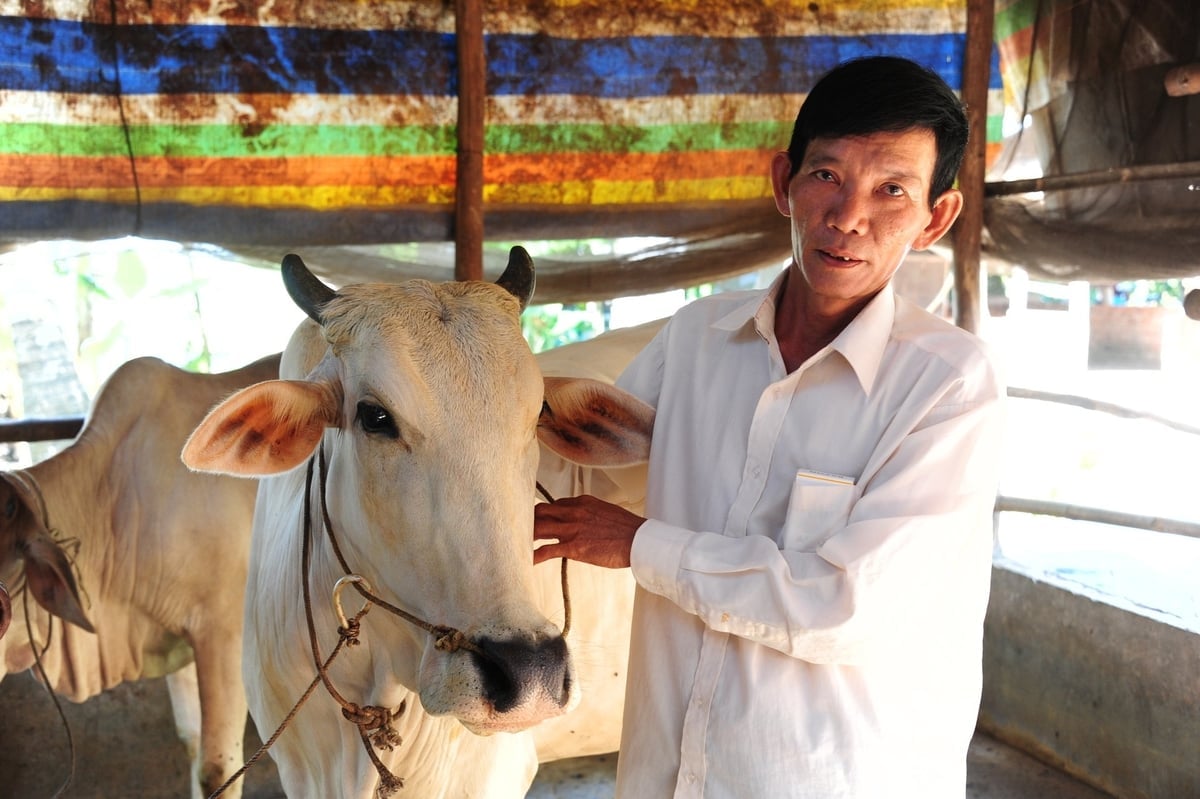December 5, 2025 | 17:53 GMT +7
December 5, 2025 | 17:53 GMT +7
Hotline: 0913.378.918
December 5, 2025 | 17:53 GMT +7
Hotline: 0913.378.918

The livestock production, animal health and fisheries sector of An Giang set the goal of at least 80% of the livestock herd receiving vaccines against dangerous diseases. Photo: Le Hoang Vu.
Aiming to stay proactive with firm determination in the prevention process against dangerous diseases in livestock, An Giang province is synchronously implementing many vaccination solutions to effectively control diseases and protect livestock production, particularly in borderlands and high-risk areas.
Statistics from the Sub-Department of Livestock Production, Animal Health and Fisheries of An Giang show that since the beginning of the year, the total livestock herd of this province has approximately 8 million poultry, nearly 100,000 pigs and more than 47,000 buffaloes and cows. Considering such a large scale, if disease control and food safety management are not implemented in time, the livestock industry will take a massive hit, thereby affecting farmers’ income.
After the Prime Minister issued Official Dispatch No. 31/CD-TTg dated April 4, 2025, directing the drastic implementation of solutions to prevent and control livestock and poultry diseases, An Giang People's Committee and specialized agencies immediately took action. The Sub-Department of Animal Husbandry, Veterinary Medicine and Fisheries of An Giang issued many plans and urgent dispatches, guiding localities to organize vaccination, monitoring, disinfection and handling of disease outbreak risks.
According to Pham Thanh Quang, Head of An Giang Sub-Department of Livestock Production, Animal Health and Fisheries, the epartment of Livestock Production, Animal Health and Fisheries has set a target that by mid-2025, at least 80% of livestock in the area will be fully vaccinated with the right type of vaccine against mandatory diseases such as avian influenza, foot and mouth disease, lumpy skin disease, rabies in dogs and cats, etc.
Up to now, most localities in the province have completed the first vaccination campaign. Some districts, including Tinh Bien, An Phu, Tri Ton, and bordering districts, have been prioritized for early and thorough vaccination to prevent diseases from entering through outside sources.
“Vaccination not only helps protect the health of livestock but is also an important criterion in building disease-free livestock areas, creating favorable conditions for exporting livestock products in the future,” said Head Pham Thanh Quang.
In the case of Tri Ton district, Nguyen Van Van, Head of the district's Office of Agriculture and Environment, mentions that the district's agricultural sector has closely coordinated with the district's Livestock Production, Animal Health and Fisheries Stations to allocate vaccines appropriately to meet the needs of each commune.
The Office of Agriculture and Environment has also organized extensive information dissemination to notify the people about the importance of vaccination. Funding for vaccination of buffaloes and cows in border communes is provided free of charge according to plan 72/CNTY, contributing to encouraging people to be more proactive during the vaccination campaign. In addition to vaccination, local veterinary forces regularly take samples to monitor disease outbreaks at hotspots, especially areas with records of outbreaks and small-scale livestock farms mixed with residential areas.

Vaccination not only helps protect the health of livestock but is also an important criterion in building disease-free livestock areas. Photo: Le Hoang Vu.
In order to effectively prevent a potential epidemic, An Giang province has strengthened control over the transportation and trade of animals across the border, especially in districts bordering Cambodia such as An Phu, Tinh Bien, and Tri Ton. Quarantine stations are active 24/7 with the coordination of other sectors, aiming to detect and strictly handle cases of transporting animals of unknown origin without veterinary quarantine.
The local authorities also step up communication work through loudspeakers, social networks, leaflets and direct conferences with livestock farmers to raise awareness of rabies, foot-and-mouth disease, avian influenza, African swine fever, as well as biosecurity measures.
“No vaccine is truly effective without the cooperation of the people. Vaccination is only truly meaningful when it reaches the entire herd. Therefore, the livestock production, animal health and fisheries sector calls on people to raise awareness of protecting livestock and comply with disease prevention measures as per instructions from professional agencies,” said the Head of An Giang Sub-Department of Livestock Production, Animal Health and Fisheries.
Thanks to the proactiveness and drastic measures of An Giang’s agricultural sector, the active participation of local authorities, and the cooperative spirit of livestock farmers, the livestock disease prevention and control work in An Giang is showing remarkable results. This is an important premise for the livestock sector to develop disease safety, aiming toward stability.
Translated by Samuel Pham

(VAN) As of 2025, the ASEAN region has a total of 69 ASEAN Heritage Parks recognized across its 10 member states. Among them, Viet Nam contributes 15 ASEAN Heritage Parks.

(VAN) Yok Don National Park has high biodiversity with numerous endemic plant and animal species, and it is also the only dipterocarp forest ecosystem conservation area in Viet Nam.

(VAN) Viet Nam and Brunei signed two important MOUs on fisheries and IUU, expanding cooperation in agriculture, the environment, and Halal exports, aiming to substantively implement joint projects.

(VAN) The Viet Nam Coconut Association worked with the International Finance Corporation (IFC) and businesses to promote the supply chain, enhance competitiveness, and develop the coconut industry sustainably.
![Hue aims for Net Zero: [2] Pioneering low-emission tourism](https://t.ex-cdn.com/nongnghiepmoitruong.vn/608w/files/huytd/2025/12/04/0633-dulichzero-4-095634_236-161125.jpg)
(VAN) The ancient capital of Hue has developed Net Zero tourism products and models, aiming to reduce carbon emissions and pioneer the establishment of Viet Nam's green tourism destination.

(VAN) C.P. Viet Nam has announced the successful completion of its goal to plant 1.5 million trees during the 2021-2025 period, a key milestone within company's long-term ESG strategy and its roadmap for emission reduction.

(VAN) This is an initiative of MAE aimed at creating a unified coordination mechanism to implement agricultural cooperation programs with developing countries.